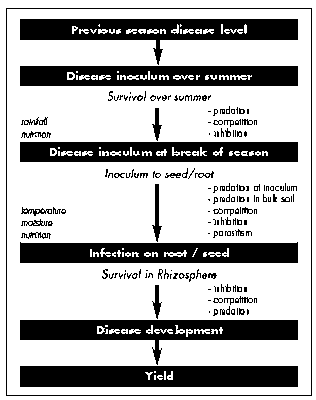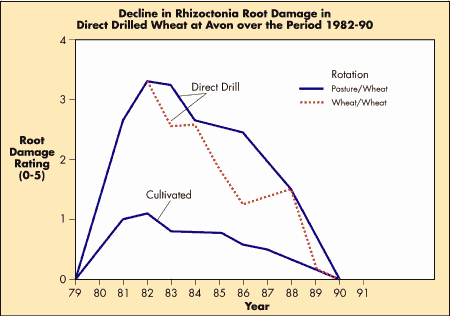
4.5 In search of a recipe for disease suppressive soil
by Stephen Neate, CSIRO Land
and Water
Take home messages:
-
Disease suppressive soils
are found throughout the world
-
We have shown that
suppression develops due to changes in soil biology
-
Suppression identified in
South Australia is against several disease organisms (pathogens) and exists in
rotations
-
Intensive cropping and
increased carbon inputs are associated with the development of suppression.
For many years, farmers and
scientists have focused on the soil organisms that cause disease, the pathogens.
However, more recently, soil organisms which prevent disease have been
put under the microscope and the search is on for farming practices which
encourage the multiplication of disease suppressive organisms.
Soil organisms carry out a
range of functions (see Figure 1). One
of these functions is disease transmission and suppression.
Suppression is restoring the balance between the soil organisms in the
soil so the pathogens do not dominate.
A suppressive soil is one
that, despite having conditions that favour the establishment of a disease
forming organism, results in the pathogen:
-
either not establishing,
-
establishing, but not
producing disease,
-
establishing and then
declining.
Suppression is not the
elimination, but the control of disease forming organisms.
In agriculture, we are trying to achieve a level of suppressiveness which
prevents disease levels that cause economic loss.
But suppression is relative - a soil may be suppressive, but disease at a
lower level is still experienced.
Table 6: Advantages and
disadvantages of controlling disease with suppressive soils
ADVANTAGES
-
reduces the legal, environmental and public
-
safety hazards of chemicals
-
should achieve control equal to the best
-
currently available by other
methods
-
can be used in organic or reduced pesticide
-
systems, thereby adding value
to the product
DISADVANTAGES
What makes a soil suppressive?
Naturally, all soils have the
capacity to suppress disease.
Microbial activity, which
depends on soil moisture, temperature and the ratio of carbon to nitrogen, is
the precursor to suppression. Table
7 illustrates the increase in soil organisms in suppressive soils compared to
organism levels in non-suppressive soil at trial sites in Avon, South Australia.
Conditions that change
biological activity or relationships between organisms can effect suppression.
Warm, moist soils with high
levels of carbon to nitrogen will have higher levels of microbial activity and a
relatively higher level of suppression.
Table 7:
Different levels of
soil biota in suppressive and non-suppressive soil at Avon SA
|
Suppressive
|
Non-suppressive
|
Microbial Biomass (µg c/g)
|
250
- 500
|
200
- 450
|
Microbial Biomass
near stubble: July
|
750 - 850
|
500 -
675
|
|
Microbial Biomass near stubble: August |
600 -
700
|
400 -
525
|
The degree of suppression
will also relate to the balance between disease-causing organisms and those
organisms which feed on these pathogens. Figure
3 illustrates that the level of disease inoculum will vary from season to
season. Consequently, a soil that
is able to suppress moderate levels of disease inoculum may not be able to
suppress disease in a year when large amounts of effective disease organisms
have survived.
Figure 3: Survival and
effectiveness of disease inoculum from one season to the next
(V Gupta)

Table 8: Disease capacity and
stubble decomposition rates for the crowns/stubble recovered from field
incubation which commenced in May
|
Disease/Decomposition level |
Date of reading |
Suppressive |
Non-suppressive |
|
Rhizoctonia solani |
July |
40 - 60 % |
> 80 % |
|
August |
< 20 % |
> 60 % |
|
Take-all (Ggt) |
July |
50 - 60 % |
>
80 % |
|
August |
30 % |
>
70 % |
|
Stubble breakdown
% broken down |
July |
25 % |
> 10 % |
|
12 months |
70 % |
35 % |
Where soils were suppressive,
the disease level fell dramatically between July and August.
At the same time rate of stubble breakdown, which is carried out by soil
organisms, was found to be greater under suppressive soils.
Which diseases can be suppressed?
In Europe, suppressive soils
have been found to suppress a single disease, for example Take-all decline.
However, this suppression requires a monoculture to be maintained.
Researchers in South Australia have found soils which are able to
suppress a range of diseases under a range of crop types and which remain
suppressive over different seasons.
Table 9:
Disease in broad
acre cropping which may or may not be suppressed
| Suppressed |
Not suppressed |
Unknown |
Rhizoctonia bare patch
Take-all
Fusarium crown rot |
Pythium root rot
CCN |
Pratylencus |
What management practices improve suppression?
Maximising the return of crop
residues to the soil has been found to increase microbial activity and turn a
soil into a disease suppressive soil.
Stubble retention and
minimising grazing have both been found to help maximise residue return.
Case Histories-Management systems under which disease
suppression has been found to develop.
Case History 1: Booborowie, South Australia
Soil type:
Red Brown Earth
Annual rainfall:
425mm
Production System:
Prior to the development of
suppression
In the early 80’s moved
into
-
more intensive cropping and stubble retention
-
narrow sowing points to minimise
soil disturbance
-
70kg DAP + Zn and 60kg Urea
-
pastures sprayed year before for weed control, cultivated
after the break with narrow sowing points and use of knockdown herbicides
Mid 90’s - suppression
recorded
Case History 2: Lock, South Australia
Soil type:
Grey Calcareous Sandy Loan
Annual rainfall:
400mm
Production System:
Non suppressive soil
-
pasture/wheat/barley rotation
-
one cultivation with narrow sowing points after the break
-
Roundup three weeks before seeding
-
Trifluralin before seeding
95kg 26:11 + Zn applied with
the seed
Suppressive soil
-
continuous crop, wheat/barley/peas rotation
-
one cultivation with narrow sowing points after the break
-
Roundup three weeks before seeding
-
Trifluralin before
seeding
95kg 26:11 + Zn applied with
the seed
How long does it take for a soil to become
suppressive?
Suppression develops over a
period of time. The duration will
depend on the conditions and the return of organic residues.
At Avon, disease suppression developed over ten years irrespective of
rotation or tillage.


4.5 In search of a recipe for disease suppressive soil
[ Back ] [ Next ]
|
